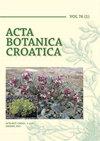Aluminum accumulation and tolerance in four Amaranthus species
IF 0.7
4区 生物学
Q3 PLANT SCIENCES
引用次数: 0
Abstract
About one-third of the earth’s land area consists of acidic soils. The rhizotoxic Al3+ is one of the primary constraints associated with low soil pH. Various Amaranthus species are important components of the weed flora in tea plantations on acid soils in north Iran. In this study, four Amaranthus species (A. blitoides, A. retroflexus, A. cruentus, and A. tricolor) were grown under hydroponic conditions with total Al concentrations of 0, 20, 50, 200, and 400 µM corresponding to free Al3+ activity of 0, 3.75, 11.97, 60.34, and 125 µM, respectively. Low Al concentrations (20, 50, or 200 µM) stimulated plant growth, A. tricolor demonstrated the highest improvement in shoot growth (93%), whereas A. retroflexus exhibited the greatest improvement in root biomass (367%), total root length (173%), and aproot length (32%). Although the response of shoot biomass to 400 µM Al varied among species, all species were able to accumulate Al in the leaves above the critical level considered for Al hyperaccumulation (1 mg g–1 DW). Our findings revealed Al accumulation in Amaranthus species for the first time at the genus and family levels, suggesting that these species are suitable for the restoration and revegetation of acid-eroded soils.四种苋属植物的铝积累和耐受性
地球陆地面积的三分之一是酸性土壤。根毒性Al3+是低土壤ph的主要制约因素之一。伊朗北部酸性土壤茶园中,各种苋属植物是杂草区系的重要组成部分。以四种苋菜(A. blitoides, A. retroflexus, A. cruentus和A. tricolor)为研究对象,在总铝浓度为0、20、50、200和400µM的水培条件下生长,其游离Al3+活性分别为0、3.75、11.97、60.34和125µM。低铝浓度(20、50或200µM)对植物生长有促进作用,三色木犀对茎部生长的促进作用最大(93%),而逆行木犀对根生物量(367%)、总根长(173%)和主根长(32%)的促进作用最大。尽管不同物种的茎部生物量对400µM Al的响应不同,但所有物种在叶片中积累的Al都超过了过量积累的临界水平(1 mg g-1 DW)。研究结果首次揭示了苋属植物在属和科水平上的铝积累,表明苋属植物适合于酸侵蚀土壤的恢复和恢复。
本文章由计算机程序翻译,如有差异,请以英文原文为准。
求助全文
约1分钟内获得全文
求助全文
来源期刊

Acta Botanica Croatica
PLANT SCIENCES-
CiteScore
2.50
自引率
0.00%
发文量
34
审稿时长
>12 weeks
期刊介绍:
The interest of the journal is field (terrestrial and aquatic) and experimental botany (including microorganisms, plant viruses, bacteria, unicellular algae), from subcellular level to ecosystems. The attention of the Journal is aimed to the research of karstic areas of the southern Europe, karstic waters and the Adriatic Sea (Mediterranean).
 求助内容:
求助内容: 应助结果提醒方式:
应助结果提醒方式:


